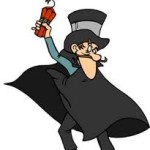
You are doomed
In my debut novel, The Fence My Father Built, my antagonist, Linc Jackson, chewed on a toothpick. An editor told me this trait made the antagonist a cliché. Over the next few revisions, I worked hard to make Linc more believable. I hope I succeeded.
Writing Tip for Today: Many of us put more effort into our protagonist than our antagonist. The result is a stereotype or clichéd antagonist. Here are some ways a fully developed antagonist will help your story:
A Worthy Adversary
Your novel’s antagonist must be at least as strong as your protagonist. If the point of your story is for your protagonist to overcome obstacles (antagonist) to achieve a goal and find resolution, you can’t give your hero or she-roe a wimpy foe. Spend at least as much time developing your story’s antagonist as you do on your protagonist. Often, if the antagonist is stronger than the protagonist (think David and Goliath), the hero’s triumph will mean much more to readers. People need to believe their lives matter, that all the oppressive forces in our lives can be surmounted. We all long to prove that with courage and persistence, the little guy can win. By giving your protagonist a strong antagonist, you show readers just how determined your protagonist turns out to be.
Deal Breaker
When my daughter was dating in college, we often discussed “deal breakers” –qualities that would automatically doom the relationship due to behavior, character flaws or habits she would not tolerate. This idea can also work for you as you build a worthy antagonist. This person can be more complex than a stereotype because he/she isn’t all bad or all good. This person’s mom still loves him! But, for the purposes of your story, the protagonist must find a “deal breaker” flaw in that person. This could be behavior, habits or personality traits which the antagonist may or may not have tried to change. But in the story, this deal breaker flaw drives the protagonist to overcome the obstacles throw up to him by the antagonist. Protagonist can no longer consider excuses or justifications for the continued flawed behavior. Your protagonist is forced into a decision that determines what he or she will or will not do to overcome the obstacles and reach the goal.
Don’t Overplay Your Antagonist
If you create antagonists who seem to be all evil or lacking in at least some semblance of human emotions, your bad guy may end up seeming rather pathetic or even comical. The twirling of the mustache, the black hat, even the chewing of toothpicks can turn off readers. Why? Because your goal is for readers to FEAR this antagonist. The story’s forward motion rides on the readers’ fears that the protagonist is going to lose everything. If readers instead laugh or dismiss the antagonist, you’re back to square one, trying to create a fully developed antagonist that can help the protagonist look good by overcoming long odds. You have to make everything around your protagonist really dark (hopeless) in order for her to shine at the climax moment. A word to sci-fi or fantasy writers: Yes, your antagonist must still possess at least a tiny bit of humanness, even though he/she is a troll, alien or Gollum. Gollum’s biggest weakness was very human–greed. It made him even more despicable. Here’s hoping your antagonist can strike fear in the hearts of your readers.
Your Turn: What’s the biggest challenge you face in creating antagonists?




